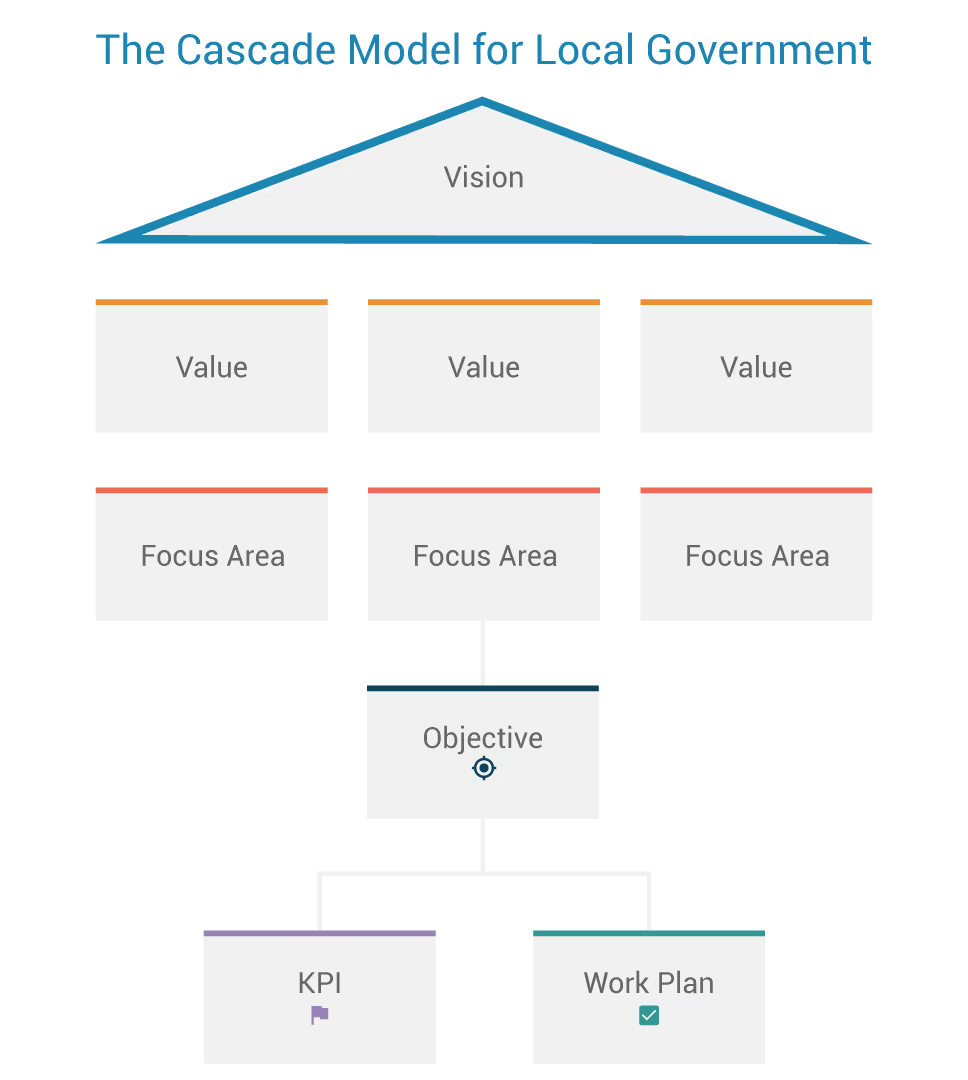Strategic planning in government can be challenging. You need to ensure stakeholder input is taken into account, your strategy is aligned across all city departments, capital projects are linked to multiple plans, and all involved are bought into the strategy.
The good news is, it can be done and the process may be easier than you think. The even better news is, we'll be sharing our local government strategic planning process for achieving this here.
We've worked with a number of local governments through the process of implementing strategy in their organization. During these implementation projects we're often asked about the best way to structure and create their strategic plan.
In order to shed some light on this recurring issue, we've decided to address this in our local government strategic planning guide.
Local Government Strategic Planning Process
The local government strategic planning process should follow the steps below:
- Environmental Scan
- Writing Your City Strategic Plan
- Strategy Roll-out to Divisions and Departments (We will touch on this in later articles)
- Executing Strategic Plan (We will touch on this in later articles)

While the above steps are a slightly simplified version of our local government strategic planning process, it should help give you an understanding of the phases in the strategy cycle as a basis - before you get caught up in the detail of the different things involved in each step.
We'll now look into the first two phases mentioned above and explain what it is, what the different components are, and how to go through each phase successfully to arrive at the next to create you government strategic plan.
Environmental Scan
When city/town managers and other executive leaders take on the task of strategic planning in government, an environmental scan should always be the first step. The environmental scan will require local governments to study and analyze the current and emerging forces that exist within their municipalities internal and external environment.
It provides city managers with comprehensive information on the current conditions of the city that may present potential opportunities, threats, strengths and weaknesses to take advantage of or mitigate.
Internal Analysis
An internal analysis examines your organization’s internal environment in order to assess its resources, competencies, and competitive advantages. Performing an internal analysis allows you to identify the strengths and weaknesses of your organization, as well as the opportunities and threats that face your organization.
This knowledge aids the strategic decision making of management while they carry out the strategy formulation and execution process. We've already created a guide to conducting an internal analysis in an earlier article, so check it out, and then come on back here to continue. As a quick overview, things you'll probably want to cover in your internal analysis will include:
- A Strategy Analysis - to help you evaluate how well you performed against your current strategic plan, what you can do better, and where you should be focusing.
- Internal Stakeholder Analysis - allows you to gather insight into the concerns and views of all internal stakeholders of your city and the impact they may have.
- SWOT Analysis - will be beneficial in gaining a holistic view of the strengths, weaknesses, opportunities and threats that face your city/town.
- VRIO Analysis - will help you identify any competitive advantages you have, and how to turn them into sustained competitive advantages.
External Analysis
An external analysis is the process of researching and examining the external environment your organization operates in, in order to determine where opportunities and threats to your town/city lie.
Just like any organization, local governments are affected by factors outside of their immediate control that they must prepare for. For example, changing legislation and policies, demographic changes, or climate concerns. Things you'll probably want to cover in an external analysis will include:
- A PESTLE analysis - to assist in identifying the different areas that may impact your city.
- An External Stakeholder Analysis - allows you to gather insight into the concerns and views of all external stakeholders of your local government and the impact they may have.
Local Government Strategic Plan Example
The actual creation of your cities strategic plan can now begin. Armed with the information and insights gathered during your environmental scan, you should now be well equipped to formulate great strategies to achieve your municipalities goals.
There is one more thing you will need to consider before actually writing your strategy - and that is the 'model' (design of strategic plan structure) that you will actually use. For the purpose of this article we're going to be using 'The Cascade Model' as we have found that this approach to strategic model is simply more effective when it comes to execution than any other model we've tried.
We've slightly adapted some of the terminology in the model to work in the context of local governments. So, with that being said..
What is the Cascade Model?
The Cascade Model is made up of 6 components. We've put together a diagram below of what the components of The Cascade Model look like in use for local government.

Vision
Your vision statement defines where you want to get to. Your Vision Statement is the anchor that stops you getting lost at sea. It will help to tunnel your strategy towards the outcomes that matter the most to your municipality.
Every single thing that you write into your plan from this point onward, will ultimately be helping you to get closer to your Vision. If your city needs a hand writing it's vision statement, check out this article for a complete guide.
An example vision statement for a local government may be.. 'A safer, smarter, healthier city which allows all our citizens to thrive'
Values
Values represent how you'll behave as an organization as you work towards your vision. Think of Values as the 'enablers' to your Vision Statement. Don't be afraid to be honest about how you want the people in your local government organization to act and think through their day to day work contributing to the strategy. If you need a hand finding the core values of your city, check out this article for a complete guide.
An examples of values held by a local government may include.. 'Diversity' 'Respect' 'Innovation' 'Trust'.
Focus Areas
Your focus areas are the high level areas that you’ll be focusing your city's efforts around as you strive towards your vision. We usually suggest creating between 3 to 5 Focus Areas. Any fewer and they will probably be too vague. Any more, and well.....I for one certainly can't focus on more than 5 things at once! For a complete guide on creating key focus areas, check out this article!
Continuing on with our local government example, focus areas may include.. 'Safe & healthy community' 'Urban experience' 'Innovative infrastructure' ''Economic vibrancy and employment'.
Strategic Objectives
Strategic Objectives represent what your city actually want to accomplish - they’re reasonably high level, but should still have a deadline attached. Your Strategic Objectives (also known as strategic goals) should align to one or more of your Focus Areas and should start to put some tangibility into what you think achieving your focus areas will look like. Typically you’ll have between 3-6 objectives for each focus area. Check out this article for a complete guide to creating awesome strategic objectives.
Borrowing from our example of focus areas above, if we were creating strategic objectives for the focus area 'Safe & Healthy Community', examples of strategic objectives may be
- 'Improve neighborhood safety by 31st of December 2022'
- 'Increase housing security by 30th of June 2022'
- 'Improve services to youth and vulnerable populations by 31st of December 2022'
Work Plans
Work plans describe what you will do to accomplish your objectives (or goals). They help convert the big picture into smaller, more manageable outcomes and tasks. It is at this point in your strategic planning process that you will start to scope out exactly what actions you will take in order to achieve certain objectives, and what skills, experience and resources will be needed. If you need a hand creating your work plans, check out this resource.
Taking our strategic objective from above 'Improve services to youth and vulnerable populations by 31st of December 2021' , an example of a work plan that would fall under this may be 'Fund an collaborate with a myriad of community organizations working in human and social services'
KPIs
KPI’s are how you will measure progress towards your strategic objectives. KPI's are measurable values that show your organization’s progress towards achieving key business objectives.
KPIs should be developed to contribute to achieving a specific goal or objective, and are how you will know if you have achieved your strategic objective or not. If you need a hand developing great KPIs, we've created a 4 step process for creating awesome KPIs.
An example of a KPI for the strategic objective 'Improve services to youth and vulnerable populations by 31st of December 2021' may be something like 'Decrease the unmet need for mental health services to 0% by 31st of December 2021'.
Local Government Strategic Plan
Following the steps detailed in this article should allow you to create a great city strategic plan. The strategic planning process should not stop here though, the strategy roll out is just as crucial to the planning process as writing the city strategic plan.
This is because the roll-out phase is when you'll have the opportunity to share the strategy with the rest of the departments in your municipality, in order for those departments to then create their own strategic plans based off the cities plan.
Without cascading the city strategy down through the organization, poor alignment between departments can foster, and confusion and inefficiencies are created.






.png)
.jpg)
.jpg)
%20(1)%20(1)%20(1)%20(1)%20(1).png)



